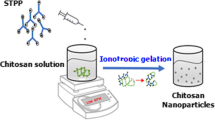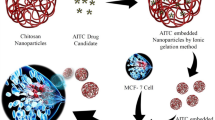Abstract
3-Amino-2-phenyl-4(3H)-quinazolinone (I) was prepared and loaded on polypyrrole chitosan (PPC) core shell nanoparticles (PPCI). The formation of core shell PPC nanoparticles were observed by transmission electron microscopy (TEM). The interaction between I and the synthesized PPC core shell nanoparticle was studied by Fourier transform infrared (FT-IR) spectroscopy. The average particle size of the PPC was 13 and 33 nm after loading I as determined by Scherer equation from X-ray diffraction (XRD) analysis. The synthesized PPCI exhibited antibacterial activity against gram negative as well as gram positive bacteria. In addition, the amount of loaded quinazolinone was calculated by thermal gravimetric analysis (TGA). The released amount of quinazolinone in different pH (2, 7.4) media and the mechanism of release by applying different model equations were studied. Moreover, the in vitro effect of the nanoparticles on Erlich ascites carcinoma (EAC) cells was enhanced after loading I.









Similar content being viewed by others
References
Ji J, Wu D, Liu L, Chen J, Xu Y (2011) Preparation, characterization and in vitro release of folic acid-conjugated chitosan nanoparticles loaded with methotrexate for targeted delivery. Polym Bull 68(6):1707–1720
Moreno PMD, Santos JC, Gomes PC, Varela-Moreira A, Costa A, Leiro V, Mansur H, Pêgo AP (2016) Delivery of splice switching oligonucleotides by amphiphilic chitosan-based nanoparticles. Mol Pharm 2:344–356
Bernkop-Schnürch A, Dünnhaupt S (2012) Chitosan-based drug delivery systems. Eur J Pharm Biopharm 81:463–469
Yalcınkay S, Demetgul C, Timur M, Colak N (2010) Electrochemical synthesis and characterization of polypyrrole/chitosan composite on platinum electrode: its electrochemical and thermal behaviors. Carbohydr Polym 79:908–913
Wang T, Ji X, Jin L, Feng Z, Wu J, Zheng J, Wang H, Xu ZW, Guo L, He N (2013) Fabrication and characterization of heparin-grafted poly-l-lactic acid-chitosan core–shell nanofibers scaffold for vascular gasket. ACS Appl Mater Interfaces 5(9):3757–3763
Attia MF, Anton N, Khan IU, Serra CA, Messaddeq N, Jakhmola A, Vecchione R, Vandamme T (2016) One-step synthesis of iron oxide polypyrrole nanoparticles encapsulating ketoprofen as model hydrophobic drug. Int J Pharm. doi:10.1016/j.ijpharm.2016.04.073
Zare EN, Lakouraj MM, Mohseni M (2014) Biodegradable polypyrrole/dextrin conductive nanocomposite: synthesis, characterization, antioxidant and antibacterial activity. Synt Met 187:9–16
Sirivisoot S, Pareta R, Webster TJ (2011) Electrically controlled drug release from nanostructured polypyrrole coated on titanium. Nanotechnology 22:85–101
Fang Y, Ni Y, Zhang G, Mao C, Huang X, Shen J (2012) Biocompatibility of CS-PPy nanocomposites and their application to glucose biosensor. Bioelectrochemistry 88:1–7
Huang H, Wu J, Lin X, Li L, Shang S, Yuen MC, Yan G (2013) Self-assembly of polypyrrole/chitosan composite hydrogels. Carbohydr Polym 95(1):72–76
Wang X, Zhou CX, Yan JW, Hou JQ, Chen SB, Ou TM, Gu LQ, Huang ZS, Tan JH (2013) Synthesis and evaluation of quinazolone derivatives as a new class of c-KIT G-quadruplex binding ligands. ACS Med Chem Lett 4(10):909–914
Ameta U, Ojha S, Bhambi D, Talesara GL (2006) Synthetic studies on some 3-[(5-arylidene-4-oxo-1;3-thiazolidin-2-yliden)amino]-2-phenylquinazolin-4(3H)-ones and their ethoxyphthalimide derivatives. ARKIVOC 2006:83–89
Gao X, Cai X, Yan K, Song B, Gao L, Chen Z (2007) Synthesis and antiviral bioactivities of 2-aryl- or 2-methyl-3-(substituted- benzalamino)-4(3H)-quinazolinone derivatives. Molecules 12(12):2621–2642
Korsmeyer RW, Gurny R, Doelker EM, Buri P, Peppas NA (1983) Mechanism of solute release from porous hydrophilic polymers. Int J Pharm 15:25–35
You P, Xing F, Huo J, Wang B, Di J, Zeng S, Liu J (2013) In vitro and in vivo evaluation of anisomycin against Ehrlich ascites carcinoma. Oncol Rep 29(6):2227–2236
Ali SW, Rajendran S, Joshi M (2011) Synthesis and characterization of chitosan and silver loaded chitosan nanoparticles for bioactive polyester. Carbohydr Polym 83:438–446
Cabuka M, Alan Y, Yavuz M, Unal HI (2014) Synthesis, characterization and antimicrobial activity of biodegradable conducting polypyrrole-graft-chitosan copolymer. Appl Surf Sci 318:168–175
Williams DH, Fleming I (1980) Spectroscopic methods in organic chemistry, 3rd edn. McGraw-Hill, London
Li Y, Li G, Peng H, Chen K (2011) Facile synthesis of electroactive polypyrrole–chitosan composite nanospheres with controllable diameters. Polym Int 60:647–651
Vivek R, Nipun Babu V, Thangama R, Subramanian KS, Kannan S (2013) pH-responsive drug delivery of chitosan nanoparticles as Tamoxifen carriers for effective anti-tumor activity in breast cancer cells. Colloids Surf B 111:117–123
Lim EK, Huh YM, Yang J, Lee K, Suh JS, Haam S (2011) pH-triggered drug-releasing magnetic nanoparticles for cancer therapy guided by molecular imaging by MRI. Adv Mater 23(21):2436–2442
Boomi P, Prabu HG, Mathiyarasu J (2013) Synthesis and characterization of polyaniline/Ag–Pt nanocomposite for improved antibacterial activity. Colloids Surf B 103:9–14
Varesano A, Vineis C, Aluigi A, Rombaldoni F, Tonetti C, Mazzuchetti G (2013) Antibacterial efficacy of polypyrrole in textile applications. Fiber Polym 14:36–42
Fischer D, Li Y, Ahlemeyer B, Krieglstein J, Kissel T (2003) In vitro cytotoxicity testing of polycations: influence of polymer structure on cell viability and hemolysis. Biomaterials 24:1121–1131
Alexander LM, Pernagallo S, Livigni A, Sánchez-Martín RM, Brickman JM, Bradley M (2010) Investigation of microsphere-mediated cellular delivery by chemical, microscopic and gene expression analysis. Mol BioSyst 6(2):399–409
Ma N, Ma C, Li C, Wang T, Tang Y, Wang H, Moul X, Chen Z, Hel N (2013) Influence of nanoparticle shape, size, and surface functionalization on cellular uptake. J Nanosci Nanotechnol 13(10):6485–6498
Liu J, Xu L, Liu C, Zhang D, Wang S, Deng Z, Lou W, Xu H, Bai Q, Ma J (2012) Preparation and characterization of cationic curcumin nanoparticles for improvement of cellular uptake. Carbohydr Polym 90(1):16–22
Jiang M, Gan L, Zhu C, Dong Y, Liu J, Gan Y (2012) Cationic core–shell liponanoparticles for ocular gene delivery. Biomaterials 33(30):7621–7630
Rybak-Smith MJ, Tripisciano C, Borowiak-Palen E, Lamprecht C, Sim RB (2011) Effect of functionalization of carbon nanotubes with psychosine on complement activation and protein adsorption. J Biomed Nanotechnol 7(6):830–839
Win KY, Feng SS (2005) Effects of particle size and surface coating on cellular uptake of polymeric nanoparticles for oral delivery of anticancer drugs. Biomaterials 26(15):2713–2722
Chithrani BD, Chan WC (2007) Elucidating the mechanism of cellular uptake and removal of protein-coated gold nanoparticles of different sizes and shapes. Nano Lett 7(6):1542–1550
Chithrani BD, Ghazani AA, Chan WC (2006) Determining the size and shape dependence of gold nanoparticle uptake into mammalian cells. Nano Lett 6(4):662–668
Author information
Authors and Affiliations
Corresponding author
Rights and permissions
About this article
Cite this article
Salahuddin, N., Elbarbary, A.A. & Alkabes, H.A. Antibacterial and antitumor activities of 3-amino-phenyl-4(3H)-quinazolinone/polypyrrole chitosan core shell nanoparticles. Polym. Bull. 74, 1775–1790 (2017). https://doi.org/10.1007/s00289-016-1804-2
Received:
Revised:
Accepted:
Published:
Issue Date:
DOI: https://doi.org/10.1007/s00289-016-1804-2




